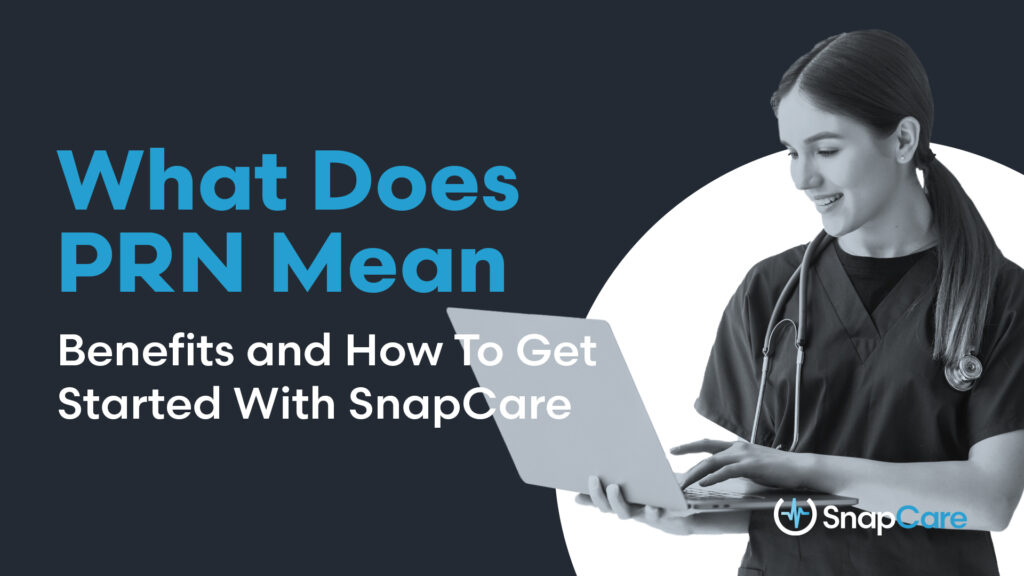In the world of healthcare, the term “PRN” often pops up, especially among nursing professionals. But what does it really mean? At SnapCare, we’re here to demystify PRN for you and explore how it can open doors to flexible, rewarding career opportunities.
Whether you’re a seasoned nurse or just beginning your journey, a solid understanding of PRN and how it works is vital to making informed choices in your nursing career.
What Does PRN Stand For
PRN is an abbreviation derived from the Latin phrase “pro re nata,” which translates to “as the situation demands.” In the healthcare sector, PRN has a broader application. It’s not just about medications but also about staffing.
PRN refers to nursing positions or shifts that are filled “as needed.” Unlike traditional, fixed-schedule roles, PRN nurses work based on the immediate needs of the healthcare facility, offering them exceptional flexibility. This kind of flexibility also plays a crucial role in hospitals and clinics where patient influx can be unpredictable.
How PRN Works
PRN positions are filled based on the fluctuating demands of healthcare facilities. This means you could be working shifts in different departments or even various healthcare settings, depending on the need.
PRN shifts are also known as “float pool nursing.” These types of shifts are flexible and have minimal scheduling requirements. Healthcare facilities generally need a mix of full-time, part-time, and PRN staff to effectively care for the community, especially during periods of increased demand, such as flu outbreaks or emergencies.
What Is a PRN Nurse
As PRN positions require you to work based on demand, they differ from full-time jobs, which have fixed hours. PRN nurses, for example, fill in gaps in the nursing schedule, work during peak times, or cover for absent staff. They enjoy more flexibility but often without the benefits of full-time employment.
PRN nursing is ideal for those who need a flexible schedule. Whether you’re balancing family responsibilities, studying, or exploring different medical facilities, PRN nursing offers a unique opportunity to manage your time effectively.
Key characteristics of PRN nursing include:
- Flexible Scheduling: PRN nurses have the ability to choose shifts that fit their availability. This allows for a more flexible work-life balance compared to traditional nursing roles.
- Variable Work Environments: They may work in different departments or healthcare settings, depending on where they are needed, offering a wide range of experiences and learning opportunities.
- No Fixed Commitment: PRN nurses do not have a set number of hours they must work each week, making this role more adaptable to personal needs and circumstances.
- Potential for Higher Pay: In some cases, PRN nurses may receive higher hourly pay compared to their full-time or part-time counterparts, compensating for the lack of regular hours and benefits.
- Adapting to New Settings: Due to the nature of their work, PRN nurses often need to quickly adapt to new environments, teams, and patient care protocols.
PRN vs. Contract Nursing
Working PRN means that you are not a part-time or full-time employee. You are not a contract or travel nurse either. You work for the facility but don’t have the typical shift requirements that part-time or full-time staff do. You also don’t receive the benefits that they do.
So how does a PRN shift differ from contract nursing shifts? Here’s a simple explanation.
Contract nurses typically work either full-time or part-time and are usually expected to complete two to three 12-hour shifts each week. They are hired for a specific period, with a predetermined end date for their employment.
Meanwhile, PRN nurses have the flexibility to work according to their own schedules without a fixed end date. They do not have strict weekly shift requirements.
Pros and Cons of PRN Work
What does PRN, which refers to as-needed healthcare roles, imply for nurses looking for work? Similar to other jobs, it comes with its own set of advantages and drawbacks.
Pros
Flexibility
As you may guessed, the biggest benefit of working PRN shifts is the flexibility they offer. With PRN shifts, you’re not tied to a fixed schedule, allowing you to decide when and where you work.
This flexibility also goes both ways: You have the freedom to work as few or as many shifts as you prefer. For instance, even if you’re only required to work a minimum of four shifts in a scheduling period, you’re free to take on additional shifts if you choose. This means your income can vary based on your immediate needs and availability.
Higher Pay
nurses taking PRN shifts often have the chance to make more money compared to full-time employees. Full-time employees usually have a fixed salary and benefits package. However, while PRN shift workers might not get the same health benefits, they generally receive higher pay.
So, what do these numbers look like? Let’s break it down. The average hourly wage for a registered nurse (RN) is about $37.31. In contrast, a nurse working PRN shifts can earn as much as $100 per hour.
Diverse Learning Experience
A great benefit of PRN shift work is the flexibility to choose from different shifts and departments, helping you broaden your skills and knowledge in multiple areas.
Look at it this way: if you want to improve your skills and maybe switch to a different specialty, working PRN shifts gives you the opportunity to do just that.
Work-Life Balance
Working as a PRN nurse essentially gives you control over your schedule, allowing you to choose when you work. This means you can plan your work around your personal life and not the other way around. If you have family commitments, hobbies, or just need some downtime, PRN nursing easily lets you fit work into your life.
Cons
Variable Hours
When you work PRN, you may not be asked to work in the same unit every shift or be guaranteed hours. For example, you could show up for work on Monday from 7 AM to 7 PM but could be sent home at 12 PM if the census changes.
The uncertainty of schedules can be a downside for those who prefer consistent work hours and fixed schedules.
Lacks Benefits and Consistent Income
For PRN nurses, there’s no guarantee of consistent hours. Work schedules are usually set ahead of time, but if a shift isn’t busy, PRN nurses might be asked to leave early, which means fewer hours and less pay. This can be a bit tricky if you rely on a steady income, especially if you’re the breadwinner in your household.
Also, a significant downside of PRN nursing is the lack of benefits. Unlike full-time positions, PRN roles usually don’t come with medical insurance, sick leave, paid vacation, or retirement plans.
High Demand for Adaptability
PRN nursing requires you to be really flexible and quick on your feet. As a PRN nurse, you might work in different departments or healthcare facilities, each with its own set of rules, team dynamics, and patient care styles. This means you have to constantly adjust to new environments, learn different procedures, and sometimes even use unfamiliar equipment, all possibly at short notice.
Getting Started With SnapCare
Step 1: Create a SnapCare account
The first step in getting started with SnapCare is creating your own account. To do this, simply head over to our website and sign up on our platform.
Step 2: Complete your Profile
When you first sign into the SnapCare app, you’ll be walked through the whole process of completing your account. Begin by confirming your job and communications preferences. Your preferences will help us know when and through what format is the best way to stay connected with you and keep you as up-to-date as possible.
Next, include all necessary information about the following:
- General information
- Work experience
- Education & Training
- Licence(s) & Certifications
- Professional Summary
- Government Issued ID
Once that is completed, you can now start viewing the job board to explore possible work opportunities that fit your preferences
Step 3: Find the Right Job
Once that is completed, you will be eligible to be matched for open assignments, and you can view our job board to express interest in assignments you want to be considered for. At this stage, you can also connect with a recruiter and get Job Fit Verified for your preferred position.
Step 4: Get Pre-Qualified & Credentialed
Get pre-qualified so we can better match you with jobs based on your personal qualifications and job preferences.
Provide the following documents & acknowledgments:
- Background check
- Skills checklist
- References
- Work Agreements
- Personal identifications
- Certifications
- Vaccination records
- COVID-19 agreement
- Employment handbook
Step 5: Complete Credentialing
Submit all the required employment forms. Along with these, you also need to provide credentialing documents to certify that you have the right qualifications and licenses for the job. Lastly, we’ll also require you to undergo a background check.
Step 6: Accept the Assignment
Make sure to confirm key details like the start and end dates, understand your pay rate, and get all necessary logistics information, such as location and reporting time.
Also, it’s important to carefully review and understand the job’s terms and requirements. To finalize the process, simply sign a Confirmation of Assignment (COA), which is your formal agreement to the job’s specifics.
Step 7: Start Working & Get Paid
Congratulations on reaching the final step! You’re now ready to start your journey with SnapCare. For the last few steps, just download the app, head out to your shifts, and submit your time cards through the app—and that’s it.
Explore PRN Work Opportunities With SnapCare
Understanding what PRN means is the first step towards a flexible and rewarding career in healthcare. Whether you’re exploring what a PRN job is or what a PRN nurse does, remember that SnapCare is here to support your journey.
With SnapCare, you can find the perfect balance between professional growth and personal commitments. So why wait? Explore the world of PRN with SnapCare today.



